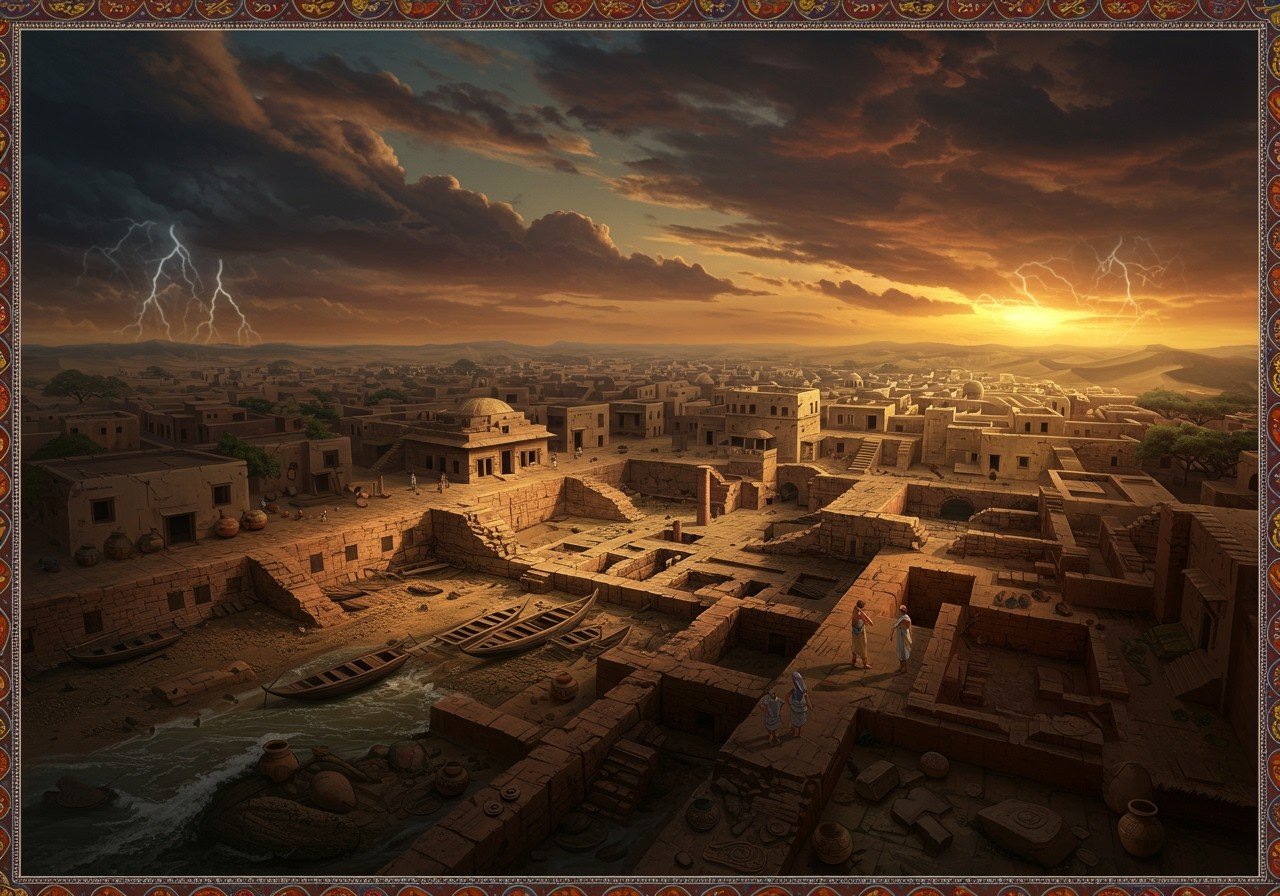
The Indus Valley Civilization, one of the world’s earliest urban societies, thrived from approximately 2600 BCE to 1500 BCE in present-day Pakistan and northwest India. Lothal, a vital port city renowned for its sophisticated drainage systems, dockyard, and bead-making industry, stood as a prominent center. However, like numerous other Indus Valley cities, Lothal eventually met its decline around 1800 BCE. This article delves into the theories surrounding the collapse of these ancient cities, exploring the influence of natural disasters and climate change on their downfall.
Theories about the Decline of the Indus Valley Civilization
The collapse of the Indus Valley Civilization has intrigued historians and archaeologists for decades. Several theories attempt to explain this phenomenon:
- Climate Change: Researchers suggest that alterations in climate patterns, such as decreased monsoon rains, resulted in agricultural failures and food shortages. This environmental shift severely impacted crop cultivation and the sustenance of large populations, ultimately weakening the civilization.
- Tectonic Activity: Geological data indicates that tectonic shifts might have altered river courses, causing vital water sources to dry up. This disruption of water availability would have severely affected agriculture and daily life, leading to the decline of cities dependent on these resources. For related insights, see our blog post on the Nira River Sangam.
- Invasion: The invasion theory proposes that Aryan tribes from Central Asia invaded and disrupted the existing social and economic structures. This external pressure could have triggered conflicts and instability, ultimately contributing to the cities’ decline.
- Trade Disruptions: Shifts in trade routes and the breakdown of trade networks could have played a role in the decline. As trade dwindled, the economy weakened, leading to the abandonment of cities that relied heavily on commercial activities.
- Social Conflict: Internal social conflicts and overpopulation might have strained resources, resulting in societal breakdown. As resources became scarce, conflicts could have erupted, further destabilizing the cities and contributing to their decline.
- Epidemics: Disease outbreaks could have decimated the population, leading to the abandonment of cities. With a reduced population, maintaining the infrastructure and daily functions of a city would have been challenging, potentially leading to its collapse.
- Environmental Degradation: Deforestation and soil erosion caused by intensive agriculture could have rendered the land unproductive. Without fertile land, agriculture would have suffered, leading to food shortages and further weakening the civilization.
- Multifactorial Causes: It’s likely that a combination of these factors contributed to the civilization’s decline. Multiple issues compounding over time could have led to the gradual abandonment of cities.
How Was Lothal Destroyed?
Lothal, situated in modern-day Gujarat, once flourished as a port city of the Indus Valley Civilization. Its decline is attributed to specific factors:
- Flooding: Evidence suggests repeated flooding, potentially caused by changes in river courses, devastated the city, damaging homes, infrastructure, and farmlands.
- Sedimentation: The gradual buildup of sediments in the dockyard rendered it unusable, impacting Lothal’s trade activities and contributing to its economic decline. This disruption of maritime activity likely played a significant role in the city’s downfall.
- Earthquakes: Seismic activity could have caused structural damage to buildings and infrastructure, making it difficult to maintain the city and potentially leading to its abandonment.
- Water Supply Issues: Changes in the course of the Sabarmati River disrupted the city’s water supply, crucial for its survival. Without a reliable water source, sustaining a large population became impossible, forcing inhabitants to migrate or face dire consequences. Explore similar challenges faced by Varanasi’s leaning temples in our blog post here.
The Impact of Natural Disasters and Climate Change on Ancient Civilizations
Natural disasters and climate change have historically influenced the decline of civilizations, and the Indus Valley Civilization is no exception:
- Floods: Recurring floods destroyed crops, homes, and infrastructure, leading to economic and social instability. The cumulative effect of flood damage weakened cities and made them vulnerable to further decline.
- Droughts: Extended droughts caused water scarcity, impacting agriculture and leading to food shortages. Without sufficient water, crop cultivation became challenging, threatening the survival of entire communities.
Poojn.in: Connecting with Ancient Traditions
As we explore the decline of ancient civilizations, it’s inspiring to see how traditions endure. Poojn.in offers a wide selection of puja items, connecting us with the spiritual practices of our ancestors. Here are some ways Poojn.in helps you preserve this rich heritage:
- Authentic Materials: We offer pure copper kalashes, brass bells, and handcrafted puja thalis, reflecting the craftsmanship of ancient times. These items add a touch of authenticity to your puja rituals, allowing you to connect with the past in a meaningful way.
- Traditional Puja Kits: Poojn.in offers complete puja kits for various ceremonies and rituals, providing all the essential items in one convenient package. This simplifies the process of performing traditional pujas, making it easier to honor ancient customs.
Explore our collection at Poojn.in and discover how we can help you connect with the spiritual practices of ancient India.
Conclusion
The decline of Lothal and other Indus Valley cities was a multifaceted process influenced by a confluence of factors. Climate change, tectonic activity, potential invasions, trade disruptions, social conflicts, epidemics, environmental degradation, and a combination of these factors all played a role. Lothal, specifically, faced severe flooding, sedimentation in its dockyard, earthquakes, and water supply issues. Understanding these challenges offers valuable lessons for modern societies facing environmental and social pressures. By studying the fate of the Indus Valley Civilization, we gain insights into the resilience and adaptability required to sustain urban centers in the face of adversity.


